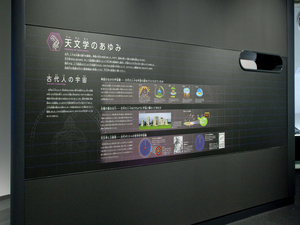Nagoya City Science Museum
TOP > Exhibition Guide > Keyword Search > Starting with "S" > summer solstice > Ancient Cosmology
Ancient Cosmology



Purpose of Exhibition
For the ancient people, the world of celestial objects was an unreachable place: the world of gods. Numerous cultures have long worshipped the gods of the sky, especially the Sun and Moon. They soon learned from their movements about the idea of day, month, and seasons.
The Mesopotamian had already found five planets intricately moving around in the starry sky. People tried to read out divine messages from them. This was the beginning of astrology, and which eventually led to the study of astronomy.
This exhibit will show you the ancient views of the Universe.
Additional Knowledge
[Stonehenge]
For the ancient people, the summer solstice, the day when the sun reaches the highest point, was considered as a very significant day when the sacred power of the sun reaches its peak. The winter solstice in contrast, as the day when the power of the sun becomes the weakest. Beyond the sunset of the winter solstice, they believed, there was the entrance to the realm of the dead. There are many ancient monuments aligned with the sunrise and sunset of the summer and winter solstice in various places of the world.
A typical example is Stonehenge, a Neolithic megalithic site on Salisbury Plain in southern England. Dozens of huge stones, each 4 to 6 meters high and 25 to 30 tons in weight, are arranged in circles, indicating the direction of the sunrise at summer solstice. Today the great part of the monument is broken, but originally, there were a stone circle with a radius of 30m, and inside the circle 5 trilithons (stones combined like a horseshoe or Japanese Torii gate). They are on a round hill 100m in diameter, from which an ancient road, "the Avenue," extends northeast, and some 30 meters away stands the Heel Stone, 6m high and 35 tons in weight.
The axis of the entire monument was precisely oriented toward the sunrise on the summer solstice, so that viewed from the center of Stonehenge the midsummer sun rises over the Heel Stone. In other words, as if led by the monument, the rays of the most sacred sunlight, passing through the Avenue, pour into the center of the stone circle. Arranged in a U-shape inside the circle, the trilithons are, as it were, a catcher's mitt receiving the holy sun light. The people who made Stonehenge might have tried to capture the summer solstice sunrise and embody the energy of the Sun on the ground.
This page was last edited on 15 June 2022.
Article by Astronomy Section
